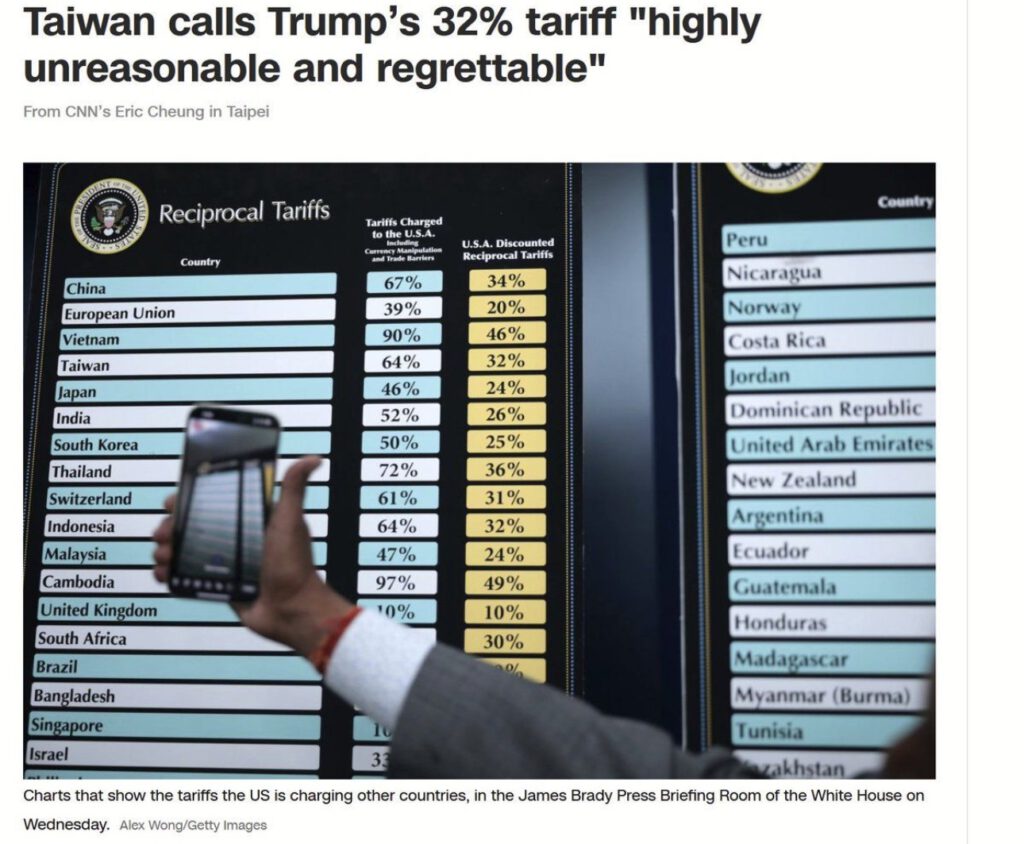An article by Chan-jo Jun.

No, of course we don’t charge the USA 39%, as Trump claimed during his press conference. He justifies his insane tariffs by saying that the whole world is ripping off the USA.
The first column shows a perceived disadvantage index based on a country’s own trade deficit divided by U.S. imports.
These are not tariffs but consumer behavior. On the chart, in fine print under “Tariffs Charged to the U.S.A.,” it says: “Including Currency Manipulation and Trade Barriers.”
These “trade barriers” include Temu and iPhone orders placed by Americans.
The issue doesn’t lie with foreigners, but with Americans themselves—who now believe justice is finally being served.
It’s astonishing how fake news can infiltrate even quantitative sciences like economics.

Additional commentary by

– A centrist democrat, because extremes destroy the country. –
Trump’s “Reciprocal Tariffs”: A Fake News Show with Volcano Islands and Mini-States
At the podium in the White House Rose Garden, Donald Trump recently presented a large board titled “Reciprocal Tariffs.” The message: the whole world is exploiting the U.S., charging high tariffs and imposing trade barriers—and now it’s payback time. A sort of economic “liberation,” as Trump called it.
But anyone who looks closely at the chart sees a bizarre mix of data tricks, half-truths, and political smoke screens designed to sell a distorted worldview.
What Trump Really Means by “Tariffs”
The central column of the chart is labeled: “Tariffs charged to the USA.” But the fine print underneath reads: “Including currency manipulation and trade barriers.”
That means: These are not real tariffs that other countries officially impose on U.S. goods, but a subjective “disadvantage index” Trump’s team has cobbled together. It’s based on trade deficits, alleged currency manipulation, and even American consumer behavior—like shopping on Chinese platforms such as Temu or importing iPhones.
In short: The “tariffs” are felt, not factual. A deliberate public deception.
Economic Reactions: Harsh Criticism and a Market Slump
After the announcement of the tariff plans, international backlash was immediate:
- Australia’s Prime Minister called the tariffs “completely unjustified,” noting that true reciprocity would mean zero tariffs—not ten percent.
- Sweden’s head of government warned that free trade is the foundation of Western prosperity—not isolation.
- The EU announced countermeasures.
Meanwhile, global stock markets dropped—from the Nikkei to the DAX to Wall Street. Gold hit a record high. Leading economists warned of the consequences of a global trade war triggered by politically motivated, economically baseless measures.
The Big List: Trump’s Fictional Tariffs for the Entire World
Trump later published a full table with over 150 countries and their alleged tariff rates. Nearly all were simply assigned “10% tariffs against the USA”—regardless of whether they even conduct trade with the U.S.
In turn, the U.S. announced dramatic retaliatory tariffs against many of these countries—some as high as 99%.
Notably, many of these countries are tiny, economically irrelevant, or even uninhabited.
(Excerpt):
| Land | Zölle auf USA | US-Gegen-Zölle |
|---|---|---|
| United Kingdom | 10 % | 10 % |
| Brazil | 10 % | 10 % |
| Singapore | 10 % | 10 % |
| Chile | 10 % | 10 % |
| Australia | 10 % | 10 % |
| Turkey | 10 % | 10 % |
| Colombia | 10 % | 10 % |
| Peru | 10 % | 10 % |
| Dominican Republic | 10 % | 10 % |
| United Arab Emirates | 10 % | 10 % |
| Argentina | 10 % | 10 % |
| Guatemala | 10 % | 10 % |
| Honduras | 10 % | 10 % |
| Egypt | 10 % | 10 % |
| Saudi Arabia | 10 % | 10 % |
| El Salvador | 10 % | 10 % |
| Morocco | 10 % | 10 % |
| Oman | 10 % | 10 % |
| Uruguay | 10 % | 10 % |
| Bahamas | 10 % | 10 % |
| Ukraine | 10 % | 10 % |
| Bahrain | 10 % | 10 % |
| Qatar | 10 % | 10 % |
| Iceland | 10 % | 10 % |
| Kenya | 10 % | 10 % |
| Haiti | 10 % | 10 % |
| Panama | 10 % | 10 % |
| Ethiopia | 10 % | 10 % |
| Jamaica | 10 % | 10 % |
| Paraguay | 10 % | 10 % |
| Lebanon | 10 % | 10 % |
| Tanzania | 10 % | 10 % |
| Georgia | 10 % | 10 % |
| Senegal | 10 % | 10 % |
| Azerbaijan | 10 % | 10 % |
| Albania | 10 % | 10 % |
| Armenia | 10 % | 10 % |
| Nepal | 10 % | 10 % |
| Sint Maarten | 10 % | 10 % |
| Gabon | 10 % | 10 % |
| Kuwait | 10 % | 10 % |
| Togo | 10 % | 10 % |
| Suriname | 10 % | 10 % |
| Belize | 10 % | 10 % |
| Liberia | 10 % | 10 % |
| British Virgin Islands | 10 % | 10 % |
| Benin | 10 % | 10 % |
| Barbados | 10 % | 10 % |
| Monaco | 10 % | 10 % |
| Land | Zölle auf USA | US-Gegen-Zölle |
|---|---|---|
| Uzbekistan | 10 % | 10 % |
| Republic of the Congo | 10 % | 10 % |
| Djibouti | 10 % | 10 % |
| French Polynesia | 10 % | 10 % |
| Cayman Islands | 10 % | 10 % |
| Kosovo | 10 % | 10 % |
| Curaçao | 10 % | 10 % |
| Rwanda | 10 % | 10 % |
| Sierra Leone | 10 % | 10 % |
| Mongolia | 10 % | 10 % |
| San Marino | 10 % | 10 % |
| Antigua and Barbuda | 10 % | 10 % |
| Bermuda | 10 % | 10 % |
| Eswatini | 10 % | 10 % |
| Marshall Islands | 10 % | 10 % |
| Saint Kitts and Nevis | 10 % | 10 % |
| Turkmenistan | 10 % | 10 % |
| Grenada | 10 % | 10 % |
| Sudan | 10 % | 10 % |
| Turks and Caicos Islands | 10 % | 10 % |
| Aruba | 10 % | 10 % |
| Montenegro | 10 % | 10 % |
| Kyrgyzstan | 10 % | 10 % |
| Yemen | 10 % | 10 % |
| Saint Vincent and the Grenadines | 10 % | 10 % |
| Niger | 10 % | 10 % |
| Saint Lucia | 10 % | 10 % |
| Iran | 10 % | 10 % |
| Samoa | 10 % | 10 % |
| Guinea | 10 % | 10 % |
| Timor-Leste | 10 % | 10 % |
| Montserrat | 10 % | 10 % |
| Mali | 10 % | 10 % |
| Maldives | 10 % | 10 % |
| Tajikistan | 10 % | 10 % |
| Cabo Verde | 10 % | 10 % |
| Burundi | 10 % | 10 % |
| Guadeloupe | 10 % | 10 % |
| Bhutan | 10 % | 10 % |
| Martinique | 10 % | 10 % |
| Tonga | 10 % | 10 % |
| Mauritania | 10 % | 10 % |
| Dominica | 10 % | 10 % |
| Micronesia | 10 % | 10 % |
| Gambia | 10 % | 10 % |
| French Guiana | 10 % | 10 % |
| Christmas Island | 10 % | 10 % |
| Andorra | 10 % | 10 % |
| Central African Republic | 10 % | 10 % |
| Land | Zölle auf USA | US-Gegen-Zölle |
|---|---|---|
| Solomon Islands | 10 % | 10 % |
| Mayotte | 10 % | 10 % |
| Anguilla | 10 % | 10 % |
| Cocos (Keeling) Islands | 10 % | 10 % |
| Eritrea | 10 % | 10 % |
| Cook Islands | 10 % | 10 % |
| South Sudan | 10 % | 10 % |
| Comoros | 10 % | 10 % |
| Kiribati | 10 % | 10 % |
| São Tomé and Príncipe | 10 % | 10 % |
| Gibraltar | 10 % | 10 % |
| Tuvalu | 10 % | 10 % |
| British Indian Ocean Territory | 10 % | 10 % |
| Tokelau | 10 % | 10 % |
| Guinea-Bissau | 10 % | 10 % |
| Svalbard and Jan Mayen | 10 % | 10 % |
| Heard and McDonald Islands | 10 % | 10 % |
| Ecuador | 10 % | 12 % |
| Trinidad and Tobago | 10 % | 12 % |
| Papua New Guinea | 10 % | 15 % |
| Saint Helena | 10 % | 15 % |
| Costa Rica | 10 % | 17 % |
| Ghana | 10 % | 17 % |
| New Zealand | 10 % | 20 % |
| Bolivia | 10 % | 20 % |
| Uganda | 10 % | 20 % |
| Democratic Republic of the Congo | 11 % | 22 % |
| Cameroon | 11 % | 22 % |
| Equatorial Guinea | 13 % | 25 % |
| Chad | 13 % | 26 % |
| Nigeria | 14 % | 27 % |
| Venezuela | 15 % | 29 % |
| Norway | 15 % | 30 % |
| Mozambique | 16 % | 31 % |
| Israel | 17 % | 33 % |
| Zambia | 17 % | 33 % |
| Philippines | 17 % | 34 % |
| Malawi | 17 % | 34 % |
| Zimbabwe | 18 % | 35 % |
| Nicaragua | 18 % | 36 % |
| Reunion | 73 % | 37 % |
| European Union | 20 % | 39 % |
| Jordan | 20 % | 40 % |
| Côte d’Ivoire | 21 % | 41 % |
| Namibia | 21 % | 42 % |
| Vanuatu | 22 % | 44 % |
| Japan | 24 % | 46 % |
| Malaysia | 24 % | 47 % |
| Brunei | 24 % | 47 % |
| Afghanistan | 10 % | 49 % |
| South Korea | 25 % | 50 % |
| India | 26 % | 52 % |
| Kazakhstan | 27 % | 54 % |
| Tunisia | 28 % | 55 % |
| Pakistan | 29 % | 58 % |
| Norfolk Island | 29 % | 58 % |
| Algeria | 30 % | 59 % |
| Nauru | 30 % | 59 % |
| South Africa | 30 % | 60 % |
| Switzerland | 31 % | 61 % |
| Moldova | 31 % | 61 % |
| Libya | 31 % | 61 % |
| Fiji | 32 % | 63 % |
| Angola | 32 % | 63 % |
| Taiwan | 32 % | 64 % |
| Indonesia | 32 % | 64 % |
| North Macedonia | 33 % | 65 % |
| China | 34 % | 67 % |
| Bosnia and Herzegovina | 35 % | 70 % |
| Thailand | 36 % | 72 % |
| Liechtenstein | 37 % | 73 % |
| Bangladesh | 37 % | 74 % |
| Serbia | 37 % | 74 % |
| Botswana | 37 % | 74 % |
| Guyana | 38 % | 76 % |
| Iraq | 39 % | 78 % |
| Mauritius | 40 % | 80 % |
| Syria | 41 % | 81 % |
| Falkland Islands | 41 % | 82 % |
| Sri Lanka | 44 % | 88 % |
| Myanmar | 44 % | 88 % |
| Vietnam | 46 % | 90 % |
| Madagascar | 47 % | 93 % |
| Laos | 48 % | 95 % |
| Cambodia | 49 % | 97 % |
| Lesotho | 50 % | 99 % |
| Saint Pierre and Miquelon | 50 % | 99 % |
——
Laugh #1: Saint Pierre and Miquelon – 6,000 Islanders vs. U.S. Imperialism
Another example on Trump’s list: the French overseas territory Saint Pierre and Miquelon, located off the coast of Canada. According to Trump, this mini-territory charges 50% tariffs on U.S. goods—and the U.S. retaliates with 99%.
Only problem: the island group has just 6,000 residents, hardly any industry, and no significant trade relationship with the United States. A trade war against a few French fishing huts—a comedy of history.
Laugh #2: Heard and McDonald Islands – Trump’s Trade War Against Penguins
Also on the list: the Heard and McDonald Islands. Trump says they charge 10% tariffs, so the U.S. will respond in kind. Sounds fair? Not really:
- The islands are uninhabited.
- They’re located in the southern Indian Ocean, about 2,500 Miles southwest of Australia.
- They’re a protected nature reserve with no economic activity—aside from glaciers, volcanoes, and a large penguin colony.
The fact that this remote, uninhabited island group appears in an official U.S. economic policy document is not just absurd, but exposes the farce behind Trump’s narrative.
Conclusion: Tariffs as Political Theater
Donald Trump’s “reciprocal tariffs” are not an economic necessity, but a propaganda tool. The underlying figures are not reliable, but ideologically interpreted. The presentation pretends to be an analytical chart, yet it’s actually a mix of felt injustice, nationalist populism, and fake news.
Instead of improving trade relations, Trump sows distrust. Instead of economic clarity, he puts on a show. And instead of addressing real problems, he wages war on penguins on volcanic islands.
An economic war against Saint Pierre, Miquelon, and uninhabited islands—welcome to Donald Trump’s world.
#Trump #FakeNews #ReciprocalTariffs #TradeWar #PenguinsVsPolitics #TariffPolicy #ShowOverStrategy #EconTheater #USA #Populism

